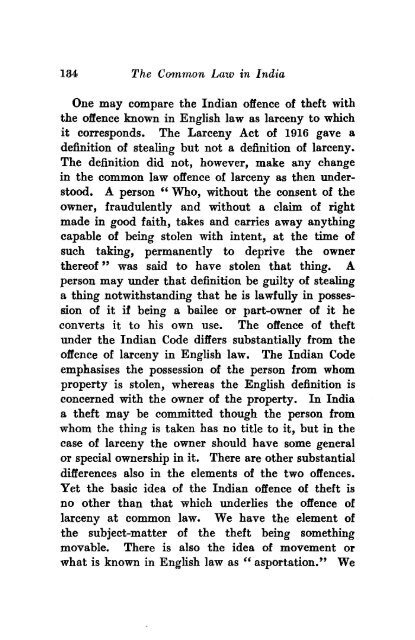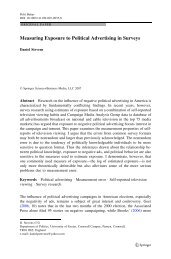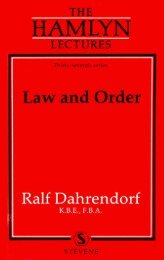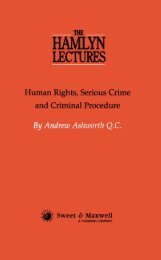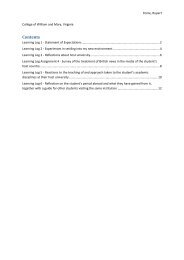The Common Law in India - College of Social Sciences and ...
The Common Law in India - College of Social Sciences and ...
The Common Law in India - College of Social Sciences and ...
- No tags were found...
Create successful ePaper yourself
Turn your PDF publications into a flip-book with our unique Google optimized e-Paper software.
134 <strong>The</strong> <strong>Common</strong> <strong>Law</strong> <strong>in</strong> <strong>India</strong>One may compare the <strong>India</strong>n <strong>of</strong>fence <strong>of</strong> theft withthe <strong>of</strong>fence known <strong>in</strong> English law as larceny to whichit corresponds. <strong>The</strong> Larceny Act <strong>of</strong> 1916 gave adef<strong>in</strong>ition <strong>of</strong> steal<strong>in</strong>g but not a def<strong>in</strong>ition <strong>of</strong> larceny.<strong>The</strong> def<strong>in</strong>ition did not, however, make any change<strong>in</strong> the common law <strong>of</strong>fence <strong>of</strong> larceny as then understood.A person " Who, without the consent <strong>of</strong> theowner, fraudulently <strong>and</strong> without a claim <strong>of</strong> rightmade <strong>in</strong> good faith, takes <strong>and</strong> carries away anyth<strong>in</strong>gcapable <strong>of</strong> be<strong>in</strong>g stolen with <strong>in</strong>tent, at the time <strong>of</strong>such tak<strong>in</strong>g, permanently to deprive the ownerthere<strong>of</strong>" was said to have stolen that th<strong>in</strong>g. Aperson may under that def<strong>in</strong>ition be guilty <strong>of</strong> steal<strong>in</strong>ga th<strong>in</strong>g notwithst<strong>and</strong><strong>in</strong>g that he is lawfully <strong>in</strong> possession<strong>of</strong> it if be<strong>in</strong>g a bailee or part-owner <strong>of</strong> it heconverts it to his own use. <strong>The</strong> <strong>of</strong>fence <strong>of</strong> theftunder the <strong>India</strong>n Code differs substantially from the<strong>of</strong>fence <strong>of</strong> larceny <strong>in</strong> English law. <strong>The</strong> <strong>India</strong>n Codeemphasises the possession <strong>of</strong> the person from whomproperty is stolen, whereas the English def<strong>in</strong>ition isconcerned with the owner <strong>of</strong> the property. In <strong>India</strong>a theft may be committed though the person fromwhom the th<strong>in</strong>g is taken has no title to it, but <strong>in</strong> thecase <strong>of</strong> larceny the owner should have some generalor special ownership <strong>in</strong> it. <strong>The</strong>re are other substantialdifferences also <strong>in</strong> the elements <strong>of</strong> the two <strong>of</strong>fences.Yet the basic idea <strong>of</strong> the <strong>India</strong>n <strong>of</strong>fence <strong>of</strong> theft isno other than that which underlies the <strong>of</strong>fence <strong>of</strong>larceny at common law. We have the element <strong>of</strong>the subject-matter <strong>of</strong> the theft be<strong>in</strong>g someth<strong>in</strong>gmovable. <strong>The</strong>re is also the idea <strong>of</strong> movement orwhat is known <strong>in</strong> English law as " asportation." We


